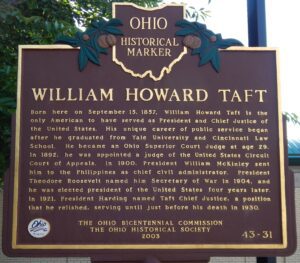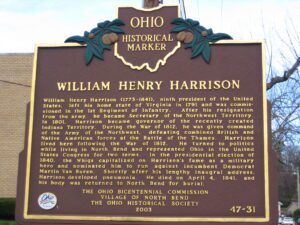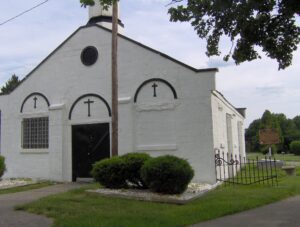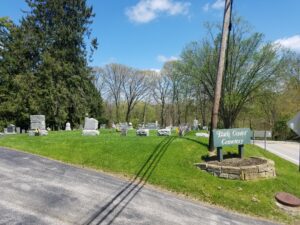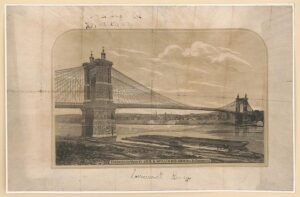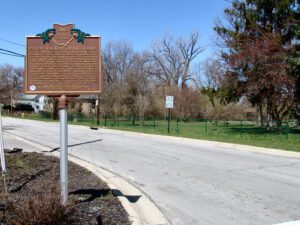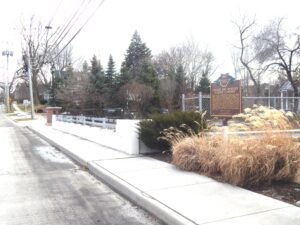, OH
Born here on September 15, 1857, William Howard Taft is the only American to have served as President and Chief Justice of the United States. His unique career of public service began after he graduated from Yale University and Cincinnati Law School. He became an Ohio Superior Court Judge at age 29. In 1892, he was appointed a judge of the United States Circuit Court of Appeals. In 1900, President William McKinley sent him to the Philippines as chief civil administrator. President Theodore Roosevelt named him Secretary of War in 1904, and he was elected president of the United States four years later. In 1921, President Harding named Taft Chief Justice, a position that he relished, serving until just before his death in 1930.
, OH
William Henry Harrison (1773-1841), ninth president of the United States, left his home state of Virginia in 1791 and was commissioned in the 1st Regiment of Infantry. After his resignation from the army, he became Secretary of the Northwest Territory. In 1801, Harrison became governor of the recently created Indiana Territory. During the War of 1812, he was given command of the Army of the Northwest, defeating combined British and Native American forces at the Battle of the Thames. Harrison lived here following the War of 1812. He turned to politics while living in North Bend and represented Ohio in the United States Congress for two terms. In the presidential election of 1840, the Whigs capitalized on Harrison’s fame as a military hero and nominated him to run against incumbent Democrat Martin Van Buren. Shortly after his lengthy inaugural address, Harrison developed pneumonia. He died on April 4, 1841, and his body was returned to North Bend for burial.
, OH
Born in Richmond, Virginia, Powhatan Beaty moved to Cincinnati in 1849, where he spent the majority of his life. Beaty enlisted as a private in the Union Army in June 1863, and two days later was promoted to first sergeant, Company G, 5th United States Colored Troops (USCT). All the officers of Company G were killed or wounded during an attack on Confederate forces at New Market Heights, Virginia, in September 1864. Beaty took command of his company, and for his valor received the Congressional Medal of Honor. Beaty was one of two African-Americans buried in Ohio to receive the Medal of Honor for service in the Civil War. He died on December 6, 1916, leaving two sons, attorney and state representative A. Lee Beaty and John W. Beaty. He is buried in Union Baptist Cemetery along with nearly 150 USCT veterans.
, OH
Settlers from New England purchased this land in 1817 for use as a burying ground and to build a meeting house. Located in the center of Bath Township, a part of the Connecticut Western Reserve, the site provided a convenient place for public and religious gatherings and for a cemetery. Out of need, the cemetery was established before the township was founded in 1818. Many of Bath Township’s farming families, as well as both owners and operators of businesses of Bath, are interred in the cemetery. In a tradition originating with Civil War veteran Perry Alexander, the graves of all veterans are marked with an American flag on Memorial Day as a tribute to their service.
, OH
The Covington-Cincinnati Bridge Company under the leadership of Amos Shinkle built the first Ohio River bridge linking the North and South following the Civil War. The bridge was privately operated until purchased in 1955 by Kentucky and later renamed the “John A. Roebling Suspension Bridge.” Completed in 1866, this National Civil Engineering Landmark was the only bridge in service over the Ohio River during the 1937 flood. Since 1976, its national and local heritage has been commemorated with beautification lighting and flags sponsored by the citizens and institutions for which the bridge stands as a community symbol. (Continued on other side)
, OH
In 1972, Urbancrest’s Ellen Walker Craig-Jones became the first African-American woman to be elected mayor, by popular vote, of a United States municipality. During her term as mayor (1972-1975), Craig-Jones oversaw the modernization of Urbancrest’s various programs and the village rebuilt three main streets, installed streetlights and street signs, and received approval to start a $3 million housing project. Craig-Jones had many years of experience in service to her community, serving twelve years on the Urbancrest Village Council. She was the recipient of dozens of awards and honors, including Who’s Who Among Black Americans.
, OH
At this location, in 1913, R. Guy Cowan opened Northeast Ohio’s only art pottery, the Cowan Pottery Studio (known first as the Cleveland Pottery and Tile Company). Cowan began molding Lakewood’s clay into sculptural forms covered with unique glazes. Cowan’s venture depended on the commercial success of his tiles, which adorned homes and community institutions throughout greater Cleveland. By 1917, his Lakewood Ware had achieved international recognition with an ward from the Art Institute of Chicago. After his World War I service, Cowan returned to Lakewood, where a drained gas well prompted the pottery’s relocation to Rocky River. Until the pottery closed in 1931, a casualty of the Great Depression, its artists produced elegant household wares and limited-edition ceramic sculptures that were sold throughout the United States and Canada.
, OH
Sylvania was once the headquarters for the Toledo and Western Railway, an electric interurban line that provided service between Toledo and Pioneer with a branch line to Adrian, Michigan. Construction began here in 1900 with planning and specifications set to steam railroad standards. With completion of rails, a powerhouse, maintenance facilities, and offices, the Toledo and Western Railway Company was soon in the business of providing freight and passenger service and was especially competitive as it owned more freight engines than most interurban lines. Operating an electric interurban line also meant that the company had the ability to provide electricity to people living in Sylvania and to other communities and property owners living along the line’s right-of-way. Besides freight, passengers, and electricity, Toledo and Western also provided postal service, one of the first interurban lines to do so. [continued on other side]


